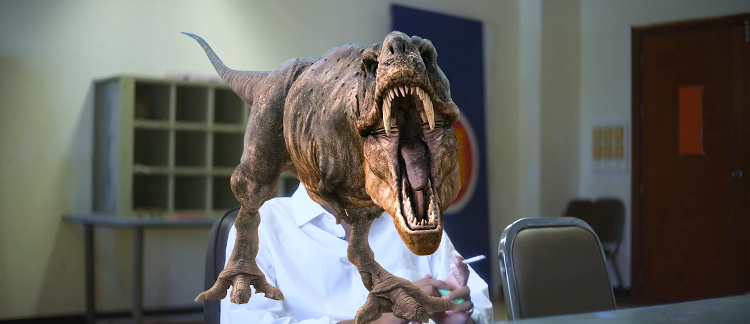
Phassarawin Kulsomboon’s new documentary Khon Boys (เด็กโขน) will be shown at the Thai Film Archive in Salaya on 16th December, in what is expected to be its only public screening in Thailand. The film had its world premiere on 15th September at Jumping Frames (跳格), the Hong Kong International Movement-Image Festival 2023.
Khon Boys follows a group of students as they learn the Thai dramatic art of khon dancing. The film opens with an introduction to the history of khon and its associations with Thai royalty: khon was traditionally performed exclusively at royal functions, and its principal characters are gods and kings. The ten kings of Thailand’s current Chakri dynasty share their name with Rama, protagonist of the khon drama Ramakien (รามเกียรติ์), and the film highlights the parallels between khon’s warrior kings and the past 200 years of Thai history.
Captions describe the Ramakien’s plot: “Rama returns home for his coronation, and his reign is one of peace and happiness.” Cut to: Sanam Luang, “15 months after King Rama X’s coronation,” where protesters gathered in September 2020 to call for reform of the monarchy. Later, there is footage of riot police firing rubber bullets at REDEM protesters at Sanam Luang in March 2021, and an impressive drone shot of 10,000 protesters assembling at Democracy Monument in August 2020. The film describes the epic Ramakien as a “great battle between Good and Evil,” and it presents the current confrontations between demonstrators and the establishment in the same terms.
Khon Boys follows a group of students as they learn the Thai dramatic art of khon dancing. The film opens with an introduction to the history of khon and its associations with Thai royalty: khon was traditionally performed exclusively at royal functions, and its principal characters are gods and kings. The ten kings of Thailand’s current Chakri dynasty share their name with Rama, protagonist of the khon drama Ramakien (รามเกียรติ์), and the film highlights the parallels between khon’s warrior kings and the past 200 years of Thai history.
Captions describe the Ramakien’s plot: “Rama returns home for his coronation, and his reign is one of peace and happiness.” Cut to: Sanam Luang, “15 months after King Rama X’s coronation,” where protesters gathered in September 2020 to call for reform of the monarchy. Later, there is footage of riot police firing rubber bullets at REDEM protesters at Sanam Luang in March 2021, and an impressive drone shot of 10,000 protesters assembling at Democracy Monument in August 2020. The film describes the epic Ramakien as a “great battle between Good and Evil,” and it presents the current confrontations between demonstrators and the establishment in the same terms.

Khon Boys is Phassarawin’s solo directorial debut, though he previously codirected Danse Macabre (มรณสติ) and the short film Dance of Death (แดนซ์ ออฟ เดธ) with Thunska Pansittivorakul. He also worked as cinematographer on Thunska’s Santikhiri Sonata (สันติคีรี โซนาตา) and Homogeneous, Empty Time (สุญกาล). Khon Boys is similar to the latter film, as they both include interviews with high-school boys about contemporary politics.
Khon Boys perfectly captures the tension between tradition and change. Just as youthful protesters in a hierarchical society are challenging conservative elites, the young khon students are participating in a royalist art form yet simultaneously questioning the ideology it represents. The film shows a social studies class that appears to be a straightforward propaganda exercise, with a writing project titled “Missing the King in Heaven”. Meanwhile, when interviewed by the director, the students criticise the lèse-majesté law and the military. As one student puts it succinctly: “Soldiers aren’t the nation’s fence. They are the king’s shield.”
Some of their comments on lèse-majesté were self-censored by the director, with photos of CGI dinosaurs to mask the forbidden opinions. (Homogeneous, Empty Time also includes a self-censored discussion of lèse-majesté.) One student resorts to a thinly-veiled metaphor, namely a fictional location in the Japanese manga series One Piece (ワンピース): “Let me talk about the country of Wano. Lord Kaido is the country’s big boss. He thinks he has limitless power and can do anything to people like us.”
Khon Boys perfectly captures the tension between tradition and change. Just as youthful protesters in a hierarchical society are challenging conservative elites, the young khon students are participating in a royalist art form yet simultaneously questioning the ideology it represents. The film shows a social studies class that appears to be a straightforward propaganda exercise, with a writing project titled “Missing the King in Heaven”. Meanwhile, when interviewed by the director, the students criticise the lèse-majesté law and the military. As one student puts it succinctly: “Soldiers aren’t the nation’s fence. They are the king’s shield.”
Some of their comments on lèse-majesté were self-censored by the director, with photos of CGI dinosaurs to mask the forbidden opinions. (Homogeneous, Empty Time also includes a self-censored discussion of lèse-majesté.) One student resorts to a thinly-veiled metaphor, namely a fictional location in the Japanese manga series One Piece (ワンピース): “Let me talk about the country of Wano. Lord Kaido is the country’s big boss. He thinks he has limitless power and can do anything to people like us.”
